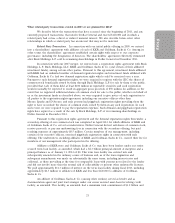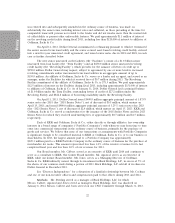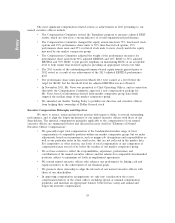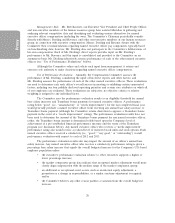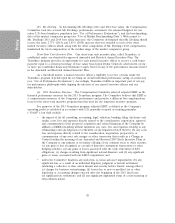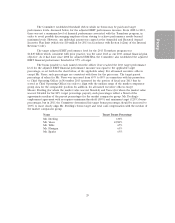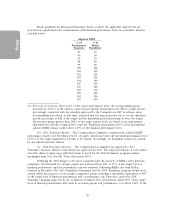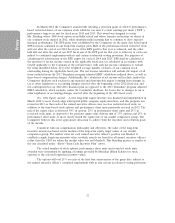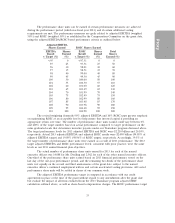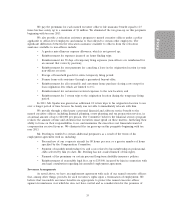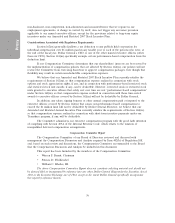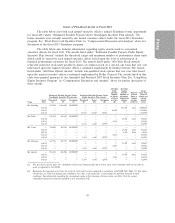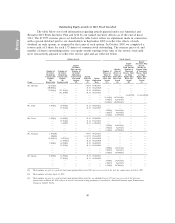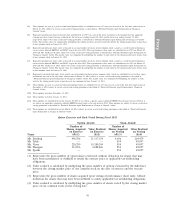Dollar General 2013 Annual Report Download - page 43
Download and view the complete annual report
Please find page 43 of the 2013 Dollar General annual report below. You can navigate through the pages in the report by either clicking on the pages listed below, or by using the keyword search tool below to find specific information within the annual report.
target level of financial performance will result in a maximum bonus payout of 300% of the individual’s
target payout percentage. Performance between 90% (threshold) and 100% of the financial
performance target, as well as between 100% and 120% (maximum) of the financial performance
target, will be interpolated on a straight-line basis on actual results for a bonus payout of between 50%
(at threshold), 100% (at target) and 300% (at the maximum) of the individual’s target payout
percentage.
Long-Term Equity Incentive Program. Long-term equity incentives motivate named executive
officers to focus on long-term success for shareholders. These incentives help provide a balanced focus
on both short-term and long-term goals and are important to our compensation program’s recruiting
and retention objectives. Such incentives are designed to compensate named executive officers for a
long-term commitment to us, while motivating sustained increases in our financial performance and
shareholder value.
Equity awards are made under our shareholder-approved Amended and Restated 2007 Stock
Incentive Plan and options are granted with a per share exercise price equal to the fair market value of
one share of our common stock on the date of grant.
(a) Pre-2012 Equity Awards. Until March 2012, the Compensation Committee had not made
annual equity awards since our 2007 merger. The options granted to the named executive officers prior
to 2012 generally were divided so that half were time-vested (over 4 to 5 years) and half were
performance-vested (generally over 5 or 6 years) based on a comparison of an EBITDA-based
performance metric, as described below, against pre-set goals. Messrs. Dreiling and Flanigan are the
only named executive officers for whom these pre-2012 options remain outstanding, and Mr. Flanigan
is the only named executive officer for whom a portion of any such options remains unvested.
The vesting of Mr. Flanigan’s performance-based options granted prior to 2012 is subject to
continued employment with us over the performance period and the Board’s determination that we
have achieved for each of the relevant fiscal years the specified annual performance target based on
EBITDA and adjusted as described below. For fiscal years 2010-2013, those adjusted EBITDA targets
were $1.400 billion, $1.584 billion, $1.754 billion and $1.930 billion, respectively, which were based on
the long-term financial plan, less any anticipated permissible adjustments, primarily to account for
unique expenses related to our 2007 merger. If a performance target for a given fiscal year is not met,
the performance-based options may still vest and become exercisable on a ‘‘catch up’’ basis if, at the
end of a subsequent fiscal year, a specified cumulative adjusted EBITDA performance target is
achieved. The annual and cumulative adjusted EBITDA performance targets are based on our
long-term financial plans in existence at the time of grant. Accordingly, in each case at the time of
grant, we believed those levels, while attainable, would require strong performance and execution.
For purposes of calculating the achievement of performance targets for our long-term equity
incentive grants prior to 2012, ‘‘EBITDA’’ means earnings before interest, taxes, depreciation and
amortization plus transaction, management and/or similar fees paid to KKR and/or its affiliates. In
addition, the Board is required to fairly and appropriately adjust the calculation of EBITDA to reflect,
to the extent not contemplated in our financial plan, the following: acquisitions, divestitures, any
change required by GAAP relating to share-based compensation or for other changes in GAAP
promulgated by accounting standard setters that, in each case, the Board in good faith determines
require adjustment to the EBITDA performance measure we use for our long-term equity incentive
program.
We have surpassed the cumulative adjusted EBITDA performance targets through fiscal 2013,
and we anticipate surpassing the cumulative adjusted EBITDA performance target through fiscal 2014
for Mr. Flanigan’s options.
31
Proxy


